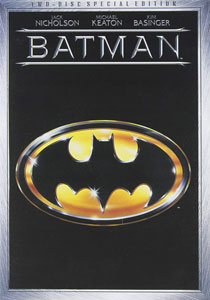With “Gotham” returning for its final season next month, I’m looking back at past “Batman” projects from the perspective of someone who enjoyed “The Animated Series” as a kid and now enjoys “Gotham.” Next up is “Batman” (1989).
WHAT’S GOOD ABOUT IT
While the Gotham City skyline matte paintings and pre-digital animations (like when armor automatically covers the Batmobile) date the film, they do so in an appealing way. To say “Batman,” like many of director Tim Burton’s films, is more style than substance is true, but the style is luscious.
WHAT’S NOT SO GOOD ABOUT IT
However, it’s not a lived-in style like on “Gotham.” It’s more like a painting (and, as noted, it often literally is). It doesn’t truly seem like people live in Burton’s Gotham City. In other words, it is indeed style-over-substance, and that’s evident in simplistic characterizations for everyone. It’s also a flat kind of style: There aren’t many new visual wonders as the narrative moves forward – although maybe in 1989 people marveled at the Batplane.

“Batman” (1989)
Director: Tim Burton
Writers: Bob Kane, Sam Hamm, Warren Skaaren
Stars: Michael Keaton, Jack Nicholson, Kim Basinger
BATMAN
Michael Keaton – the first actor to portray the Dark Knight version of Batman (as opposed to the campy version) — is fine inasmuch as I root for Batman to defeat the Joker, and he seems like a nice guy. It makes sense that Kim Basinger’s Vicki Vale likes Bruce as a person, genuinely seeing beyond the fact that he’s rich.
Batman is just embarking on his crimefighting career here; it’s like “Year One” in that regard. He starts as a rumor pursued by reporter Alexander Knox (Robert Wuhl), whose colleagues laugh at him (even though he’s doing exactly what any good reporter should do). And when Batman fights even the most basic of Joker’s thugs, it’s a challenging fight; this stuff isn’t a walk in the park for him.
For being “the world’s greatest detective,” Batman seems a bit slow on the uptake here. A thug saying the name “Jack” is ingrained in Bruce’s memory of his parents’ murder, along with the killer’s grin. (Good job casting a young actor who resembles Jack Nicholson, by the way.) As Jack Napier climbs to power in Gotham, Bruce doesn’t make the connection. Granted, Napier operates somewhat behind the scenes, but even when Bruce meets him face-to-face, he doesn’t immediately put it together.
In 1989, the biggest comparison among superhero movies was Christopher Reeve’s Superman. While those four “Superman” films aren’t a lot better than “Batman” (indeed, two are certainly worse), Supes paves a quicker path to a film viewer’s heart than the understated Bats does.
ALLIES
Vicki Vale has a robust role as a photojournalist who falls for Bruce/Batman. Basinger is 1980s pretty and – with Knox being a goofball – she’s the level-headed audience surrogate (and the character who seems most like a real person), providing the credulous outsider’s perspective on this city’s insane culture of crime, corruption and vigilantism.

Alfred is of course on hand, and Michael Gough is in the wise-and-kind butler incarnation of the character, which was standard at the time.
VILLAINS
Nicholson plays an iconic Joker, chewing scenery in not only this film but also in the adjacent theaters. His constant laughter borders on annoying, but I admit I did chuckle when he randomly pulls out a pair of spectacles and says “You wouldn’t hit a guy with glasses?”
In the most obvious case of streamlining comics lore for the sake of a film, here it’s the Joker who killed Bruce’s parents, and it’s Bruce who drops Joker into the vat of acid (albeit not on purpose). Screenwriters Sam Hamm and Warren Skaaren bluntly express the theme of the Joker having “made” Batman, and Batman having “made” the Joker, with the foes discussing it in the bell-tower fight.
While the notion of the Joker having an unknown backstory is sacrosanct among comic fans (even “The Killing Joke” only gives us “origin stories” from the unreliable Joker himself), this film does give us a straightforward backstory: The Joker is Jack Napier, a thug who has worked his way up the ranks of the city’s crime circles.
I like the way Bob the Goon (Tracey Walter) is always reliably at the Joker’s side but doesn’t talk. He’s the perfect henchman, and it’s dumb (albeit memorable) when the Joker shoots him for no good reason. It’s probably meant to show us how the Joker is unhinged, but it doesn’t feel right. Sure, the Joker is nuts, but he’s also cunning, not truly random in his behavior. On a related note: As solid as Bob is, inserting Harley Quinn in that role could’ve upped the fun factor – but she hadn’t been invented yet.
THAT’S FAMILIAR
- Danny Elfman’s “Batman” score originates here, and it became so iconic that a few years later “The Animated Series” flat-out adopted it as its theme song.
- The cavernous, old-architecture newspaper office reminds me of the police precinct on “Gotham.”
THAT’S SURPRISING
- Bruce Wayne isn’t famous in the Burton-verse. He’s rich, and he lives in a mansion, but there’s no mention of Wayne Enterprises or any way in which the Wayne family is ingrained in Gotham City. At the party, Vicki doesn’t know what Bruce looks like.
- Bruce/Batman has no relationship whatsoever with the police. Even when he supplies them with the Bat Signal spotlight at the end, it happens off screen. So there’s not a single scene between Batman and Commissioner Gordon. It’s also surprising that – after early scenes show Officer Eckhardt (William Hootkins) as dirty cop – the police don’t play much of a role here. The investigative side of things is covered by journalists Knox and Vale.
- Alfred simply lets Vicki into the Batcave to see Bruce. The idea of giving up his secret identity isn’t a complete no-no. Alfred is in favor of it, if it’s someone trustworthy. And once the cat’s out of the bag, it’s not a big deal for either Bruce or Vicki.
THAT’S WEIRD
- Vicki seems to be a freelancer who is borrowing a desk at the newspaper while she’s in town trying to get photos of this so-called Batman that Knox has been writing about. Later, she seems to have an apartment. I suppose it could be a short-term rental. It strikes me that it’s not something even a successful photojournalist could afford, but then again, the industry was different 30 years ago.
- Several songs in “Batman” are written and performed by Prince. Similar to scenery-chewing turns by Nicholson, I’ve never seen the appeal of Prince. The two Purple Ones teaming up is natural, I suppose – the Joker mugging through choreographed scenes while Prince croons through a boom box – but it seems goofy now.
FINAL THOUGHTS
I didn’t have as much fun with “Batman” as I did with the first two “Supermans,” and it doesn’t live up to my fond memories of “The Animated Series.” It’s a pretty film, but it’s a flat one, too. It just stays at the same level of looking good without giving us anything deep from the characters or surprising from the plot. As the first on-screen portrayal of the Dark Knight version of Bats, it’s respectable, but – irrespective of all the inferior or superior Batman films since — I don’t think it has aged all that well.

